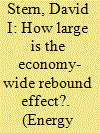| Srl | Item |
| 1 |
ID:
099273


|
|
|
|
|
| Publication |
2010.
|
| Summary/Abstract |
Several developing economies have announced carbon emissions targets for 2020 as part of the negotiating process for a post-Kyoto climate policy regime. China and India's commitments are framed as reductions in the emissions intensity of the economy by 40-45% and 20-25%, respectively, between 2005 and 2020. How feasible are the proposed reductions in emissions intensity for China and India, and how do they compare with the targeted reductions in the US and the EU? In this paper, we use a stochastic frontier model of energy intensity to decompose energy intensity into the effects of input and output mix, climate, and a residual technology variable. We use the model to produce emissions projections for China and India under a number of scenarios regarding the pace of technological change and changes in the share of non-fossil energy. We find that China is likely to need to adopt ambitious carbon mitigation policies in order to achieve its stated target, and that its targeted reductions in emissions intensity are on par with those implicit in the US and EU targets. India's target is less ambitious and might be met with only limited or even no dedicated mitigation policies.
|
|
|
|
|
|
|
|
|
|
|
|
|
|
|
|
| 2 |
ID:
177095


|
|
|
|
|
| Summary/Abstract |
The size of the economy-wide rebound effect is crucial for estimating the contribution that energy efficiency improvements can make to reducing greenhouse gas emissions and for understanding the drivers of energy use. Economy-wide rebound from an energy efficiency improvement includes changes in the use of energy to produce complementary and substitute goods or inputs and other flow-on effects that affect energy use across the economy as well as the direct rebound due to energy users using more of an energy service that has become less costly as result of improved energy efficiency. Jevons first argued in 1865 that improvements in energy efficiency increase total energy use, and in recent decades researchers have argued for and against this “backfire” hypothesis. Theory provides some guidance on the factors affecting rebound but does not impose much constraint on the range of possible responses. Historical evidence suggests that the improved energy efficiency of recent technology has not reduced energy use because consumption has shifted to more energy-intensive goods and services. Simulations and econometric research have produced mixed results. Some recent general equilibrium studies find large rebound, around 100%, but more research is needed to confirm or refute these findings.
|
|
|
|
|
|
|
|
|
|
|
|
|
|
|
|